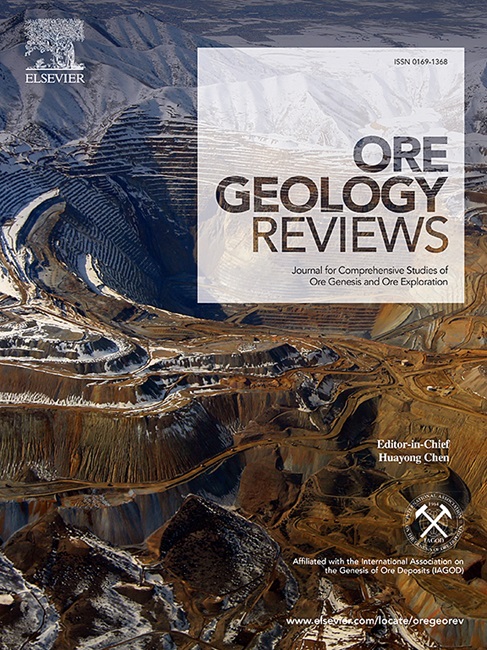Distribution and enrichment mechanism of rhenium in sediment-hosted stratiform copper deposits: A case study from the Tangdan deposit, SW China
IF 3.2
2区 地球科学
Q1 GEOLOGY
引用次数: 0
Abstract
Sediment-hosted stratiform copper (SSC) deposits are globally significant copper resources and contain critical metals such as Co, Re, and Ge. The Tangdan deposit, located in the Kangdian metallogenic belt within the western Yangtze block, is a prime example of SSC deposits in China. It comprises two types of ores: bedded ores with parallel bedding, and minor discordant vein-type high-grade ores. The sulfides in both types include chalcopyrite, bornite, chalcocite, tetrahedrite, digenite, and traces of galena and pyrite. Sulfides from vein-type ores show Re contents 10 to 100 times higher (0.01–1.67 ppm) than those in the bedded ores (0.06–0.27 ppm). However, the mechanism driving this disparity in Re content between ore types remains unclear. In the bedded ores, Re is preferentially partitioned into secondary digenite over primary sulfides such as chalcopyrite, bornite, chalcocite, and tetrahedrite. The relative Re enrichment in digenite is likely due to oxidization alteration, as Re is highly sensitive to oxygen fugacity. In contrast, Re in the vein-type ores predominantly associates with chalcocite, likely because of its high Mo content. Additionally, sulfides in vein-type ores typically have higher Zn, Mo, Sb, Re, and Pb concentrations than bedded ores. The δ34S values of Cu-sulfides in bedded ores range from +1.7 ‰ to +11.5 ‰, whereas those in vein-type ores span from −13.3 ‰ to −4.8 ‰. The sulfur isotope geothermometer for coprecipitated chalcopyrite and bornite indicates that the average formation temperature for vein-type ores is 364 °C. Based on trace elements, sulfur isotope, and formation temperature of sulfides, we propose that bedded and vein-type ores have different formation mechanisms. Copper and other ore-forming elements were leached from the source bed by low-temperature (171 °C), Re-poor basin brine, while marine sulfate provided reducing sulfur, triggering redox reactions that formed bedded ores. In contrast, vein-type ores accumulated Re through the interaction between high-temperature hydrothermal fluids (364 °C) and Re-rich carbonaceous slate. The continuous dissolution of dolostone in high-temperature fluids increases pH and promotes the precipitation of sulfides, ultimately leading to the formation of Re-rich vein-type ores. This model for Re migration and enrichment at the Tangdan deposit could have broader applications for SSC deposits globally and serves as an exploration guide for critical metals in SCC deposits.

沉积型地层铜矿床中铼的分布与富集机制:中国西南部汤丹矿床案例研究
沉积成因地层铜(SSC)矿床是全球重要的铜资源,含有 Co、Re 和 Ge 等重要金属。唐丹矿床位于长江西部地块的康店成矿带,是中国 SSC 矿床的典型代表。该矿床由两种类型的矿石组成:平行层理的层状矿石和次要的不和谐脉型高品位矿石。这两种类型的硫化物包括黄铜矿、辉铜矿、白铜矿、四面体矿、地开石以及微量方铅矿和黄铁矿。矿脉型矿石中硫化物的 Re 含量(0.01-1.67 ppm)比矿床型矿石中的 Re 含量(0.06-0.27 ppm)高 10 到 100 倍。然而,造成矿石类型之间 Re 含量差异的机制仍不清楚。在层状矿石中,与黄铜矿、辉铜矿、方铅矿和四面体矿等原生硫化物相比,Re更倾向于被分配到次生二长石中。由于 Re 对氧气的富集度非常敏感,因此锰矿中 Re 的相对富集可能是由于氧化蚀变造成的。相比之下,脉石型矿石中的铼主要与方铅矿结合,这可能是因为方铅矿的钼含量较高。此外,脉型矿石中硫化物的锌、钼、锑、铼和铅浓度通常高于层状矿石。层状矿石中硫化铜的δ34S值从+1.7‰到+11.5‰不等,而脉状矿石中的δ34S值则从-13.3‰到-4.8‰不等。共沉淀黄铜矿和辉铜矿的硫同位素地温仪显示,脉型矿石的平均形成温度为 364 ℃。根据硫化物的微量元素、硫同位素和形成温度,我们认为层状矿石和脉状矿石具有不同的形成机制。铜和其他成矿元素是由低温(171 °C)再贫盆地盐水从矿床浸出的,而海洋硫酸盐提供了还原硫,引发了氧化还原反应,形成了层状矿石。相反,脉型矿石则是通过高温热液(364 °C)和富Re碳质板岩之间的相互作用积累Re的。白云石在高温流体中的持续溶解增加了pH值,促进了硫化物的沉淀,最终形成富Re脉型矿石。唐丹矿床的这一 Re 迁移和富集模型可广泛应用于全球的 SSC 矿床,并可作为 SCC 矿床中关键金属的勘探指南。
本文章由计算机程序翻译,如有差异,请以英文原文为准。
求助全文
约1分钟内获得全文
求助全文
来源期刊

Ore Geology Reviews
地学-地质学
CiteScore
6.50
自引率
27.30%
发文量
546
审稿时长
22.9 weeks
期刊介绍:
Ore Geology Reviews aims to familiarize all earth scientists with recent advances in a number of interconnected disciplines related to the study of, and search for, ore deposits. The reviews range from brief to longer contributions, but the journal preferentially publishes manuscripts that fill the niche between the commonly shorter journal articles and the comprehensive book coverages, and thus has a special appeal to many authors and readers.
 求助内容:
求助内容: 应助结果提醒方式:
应助结果提醒方式:


